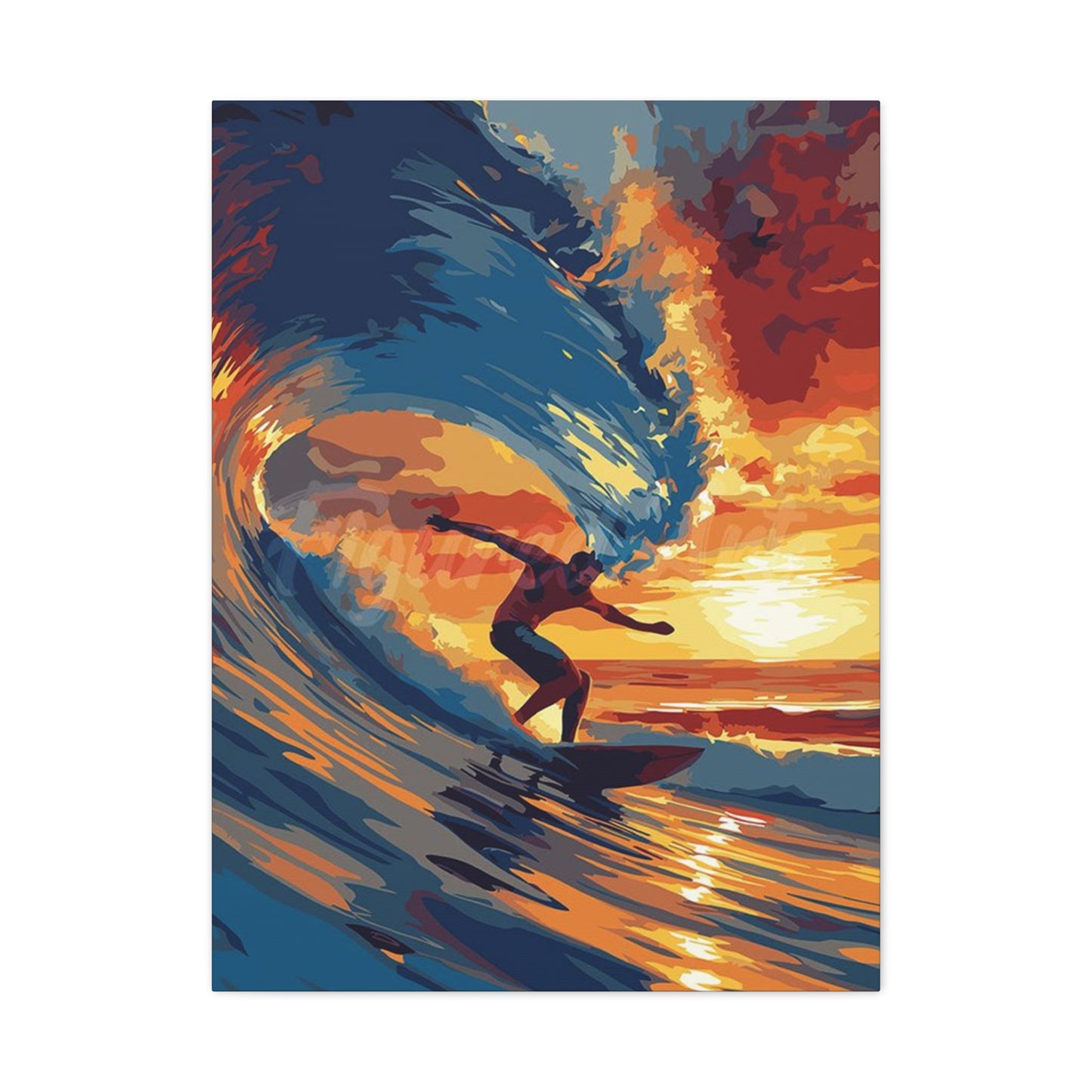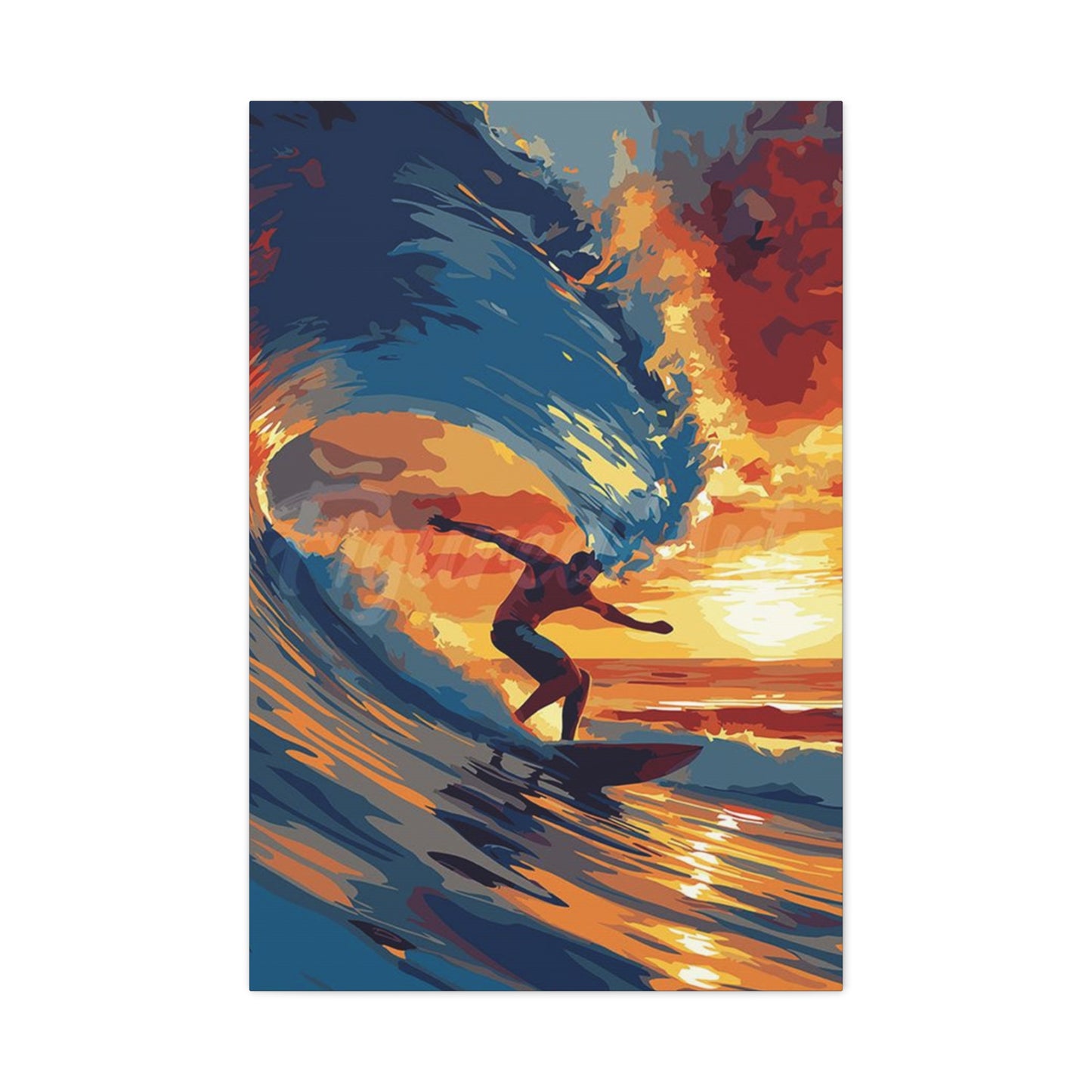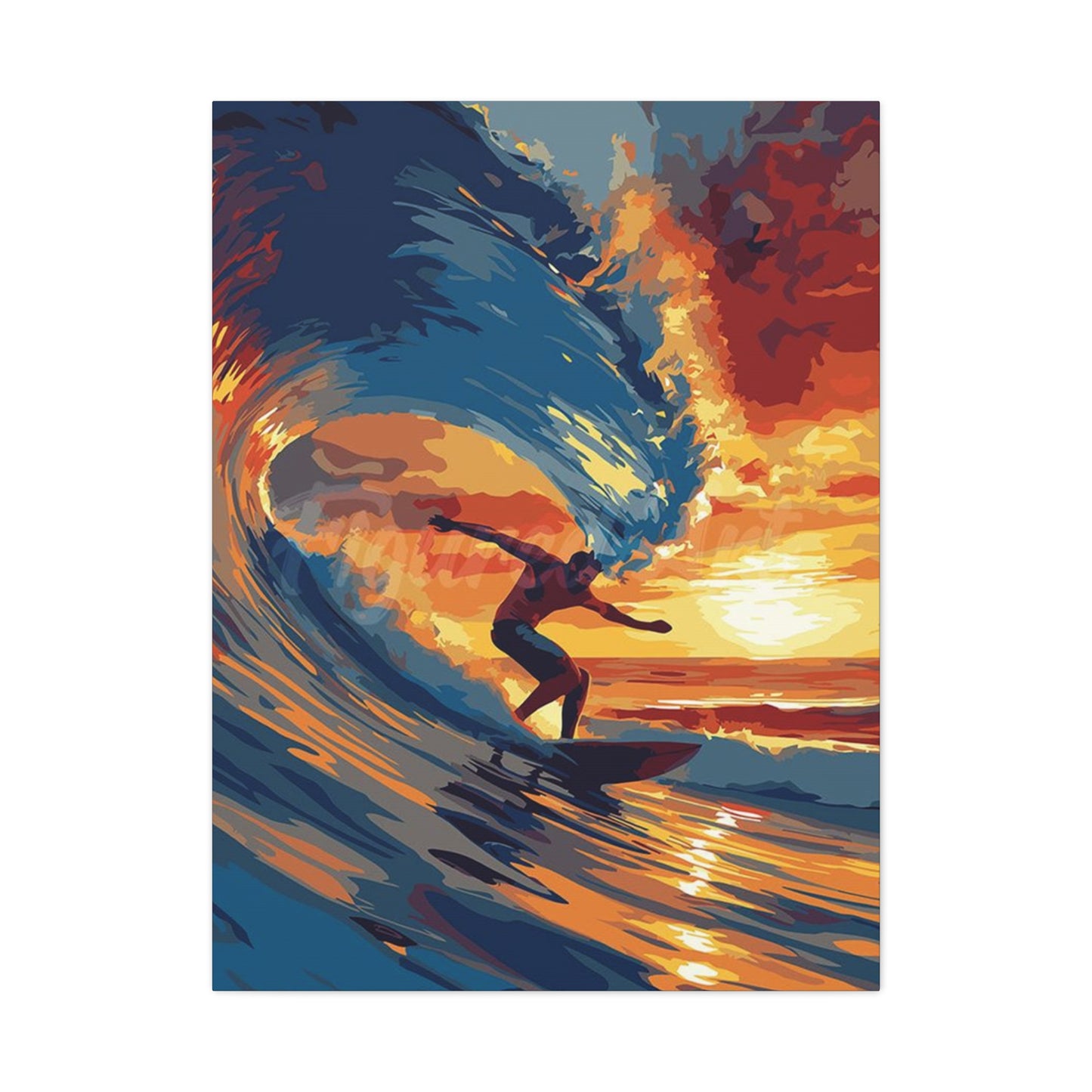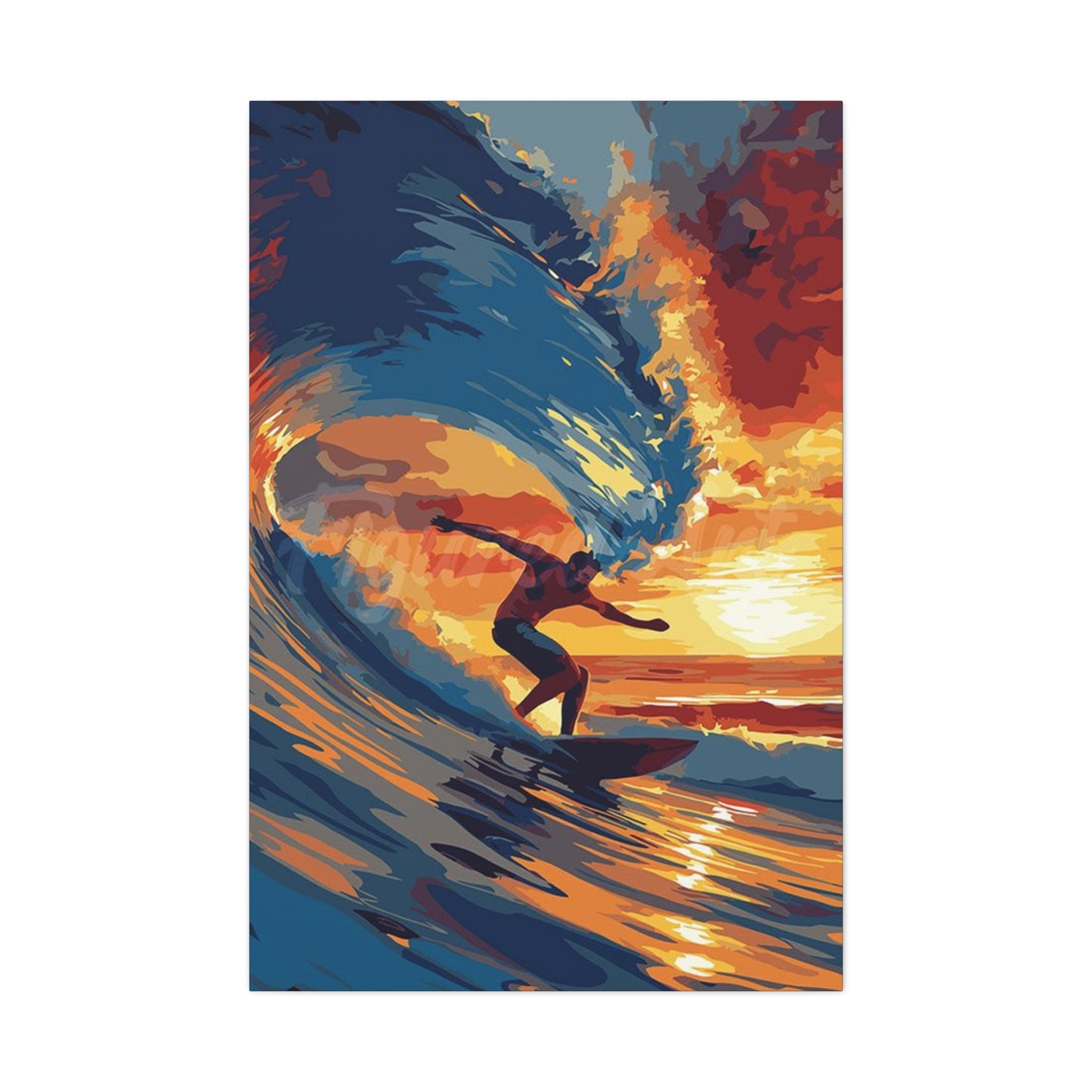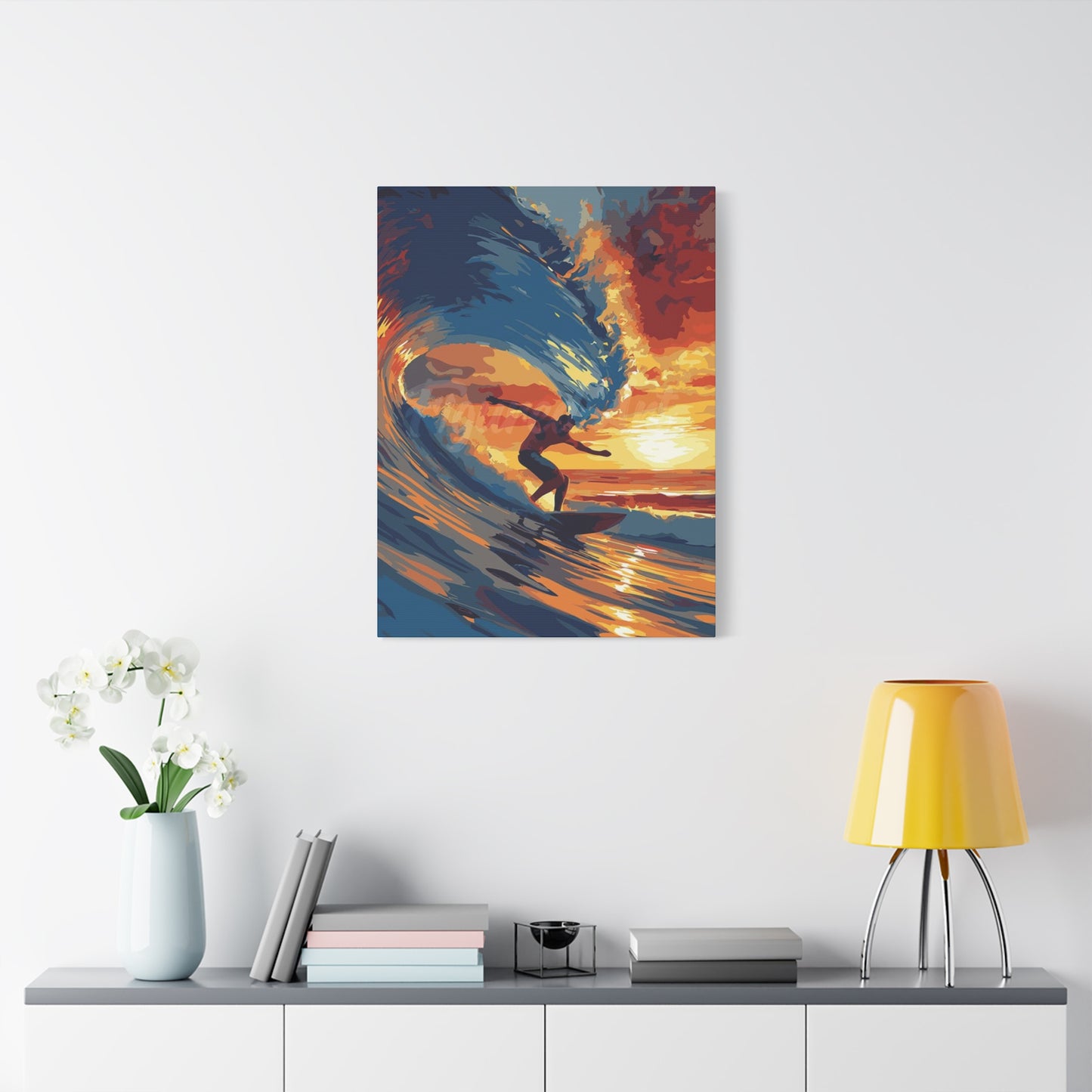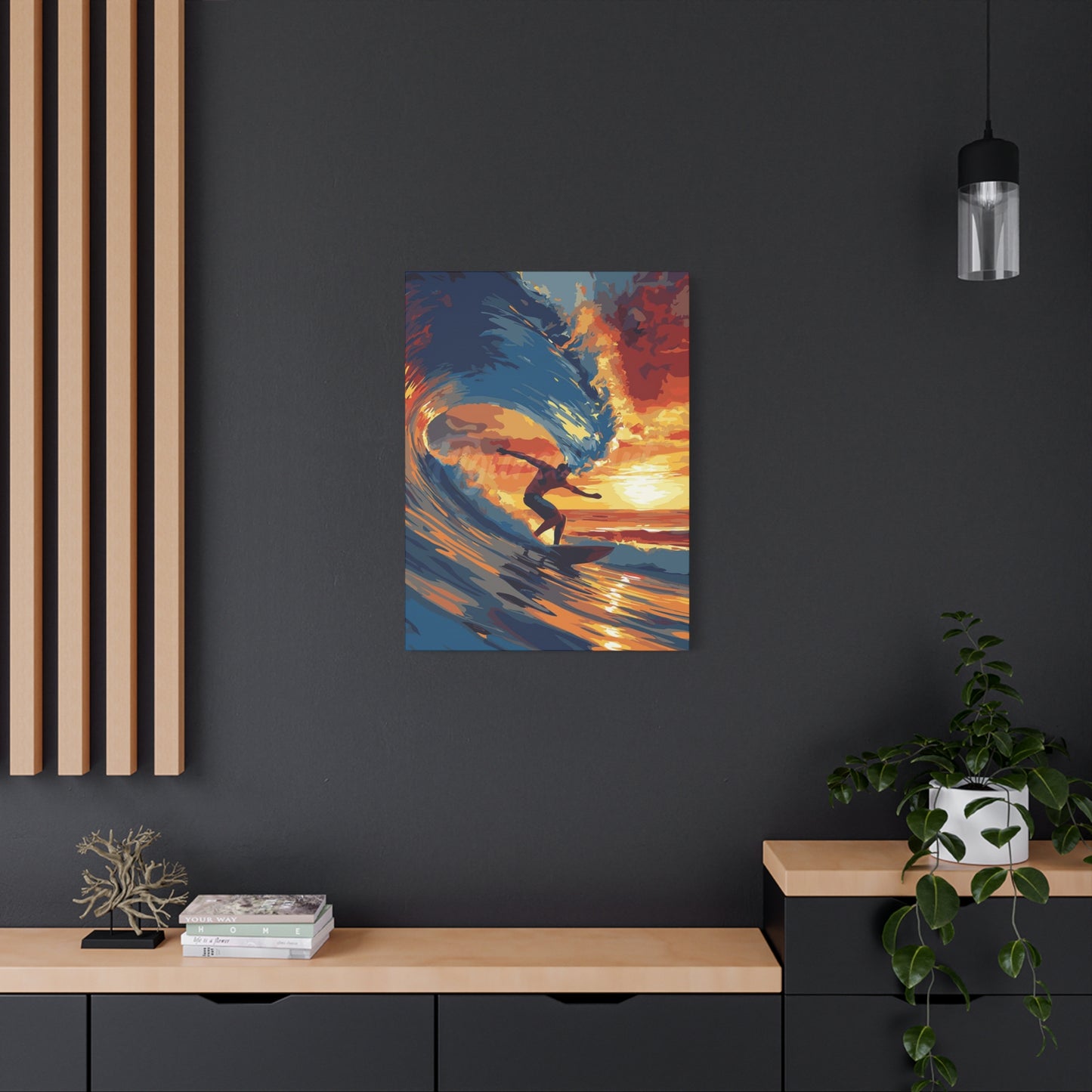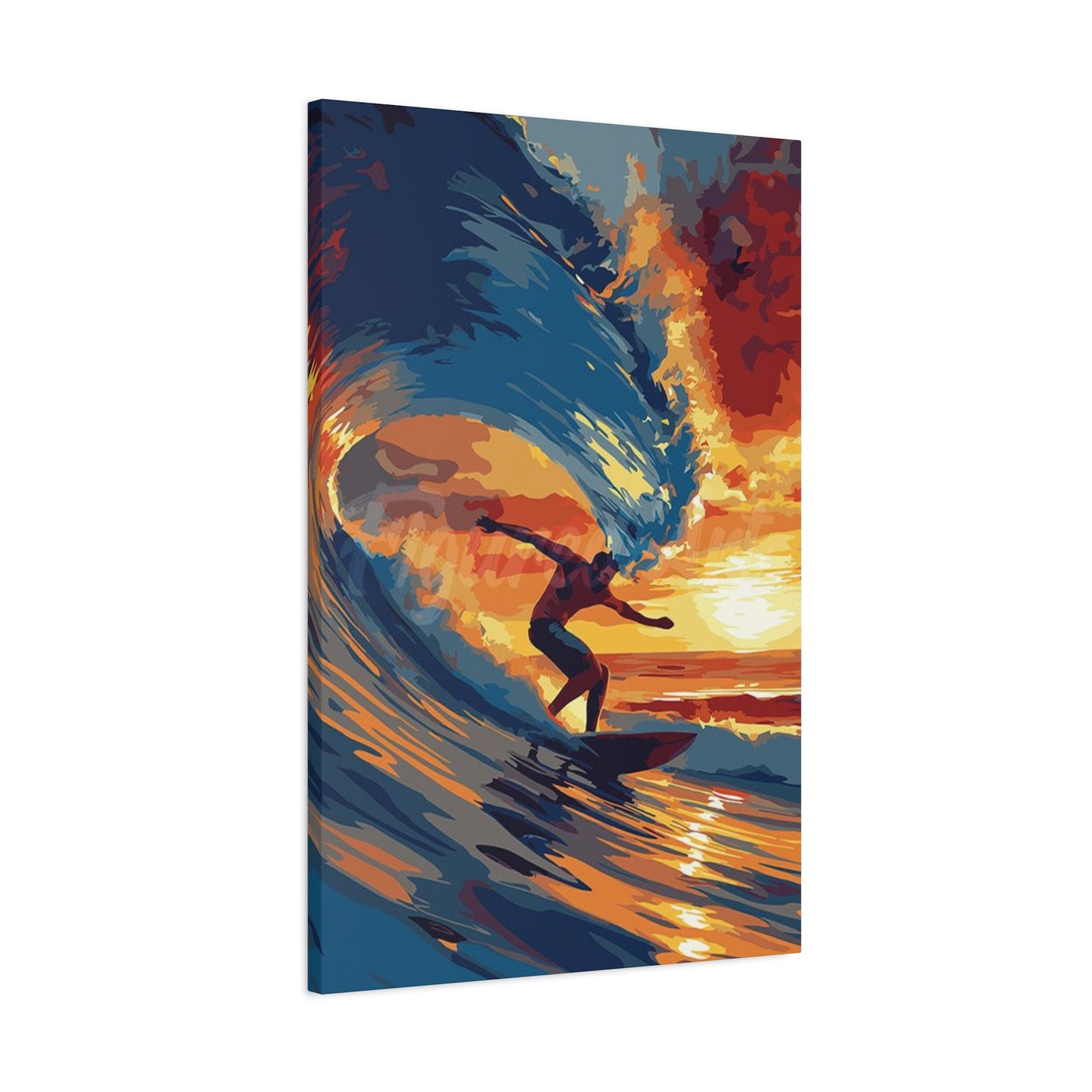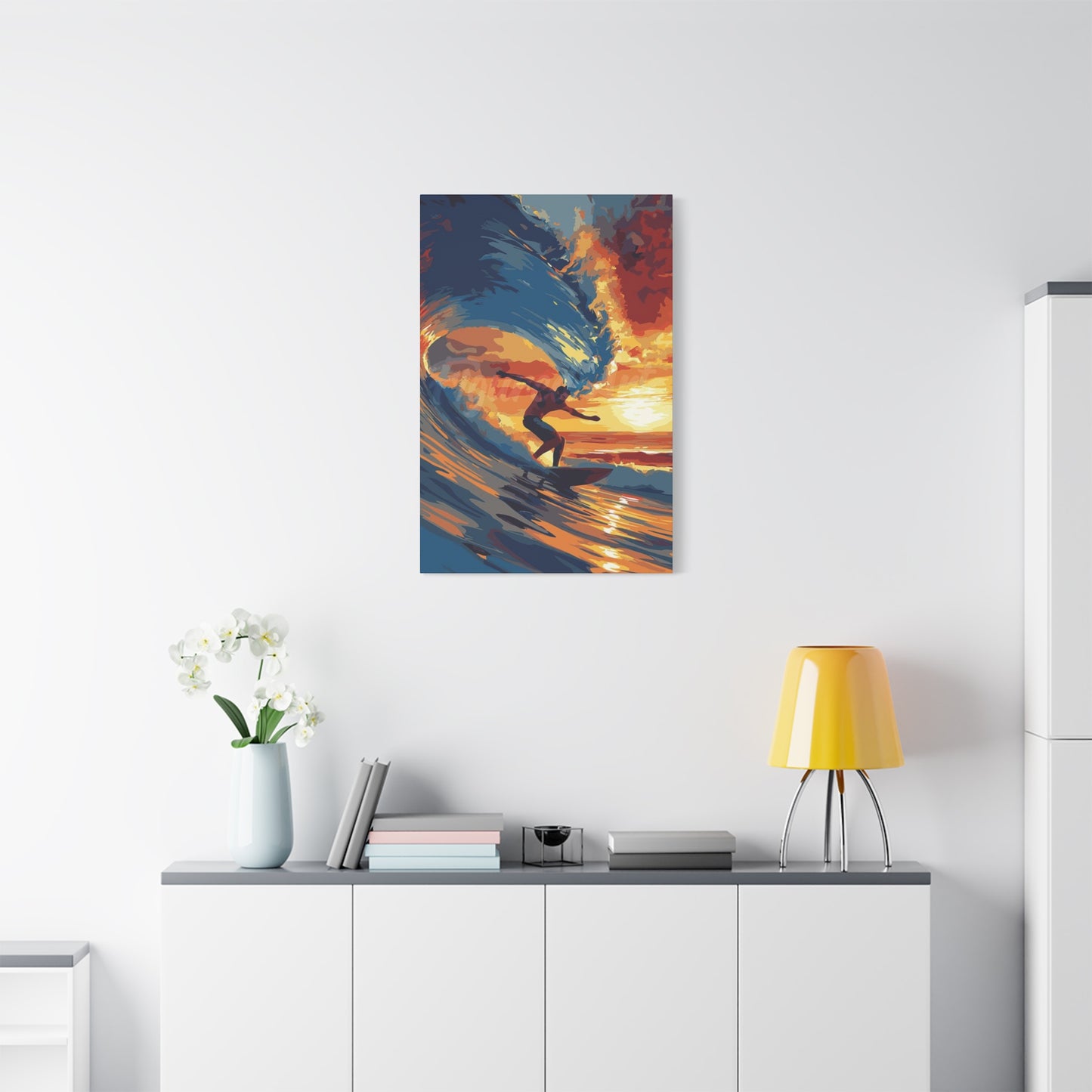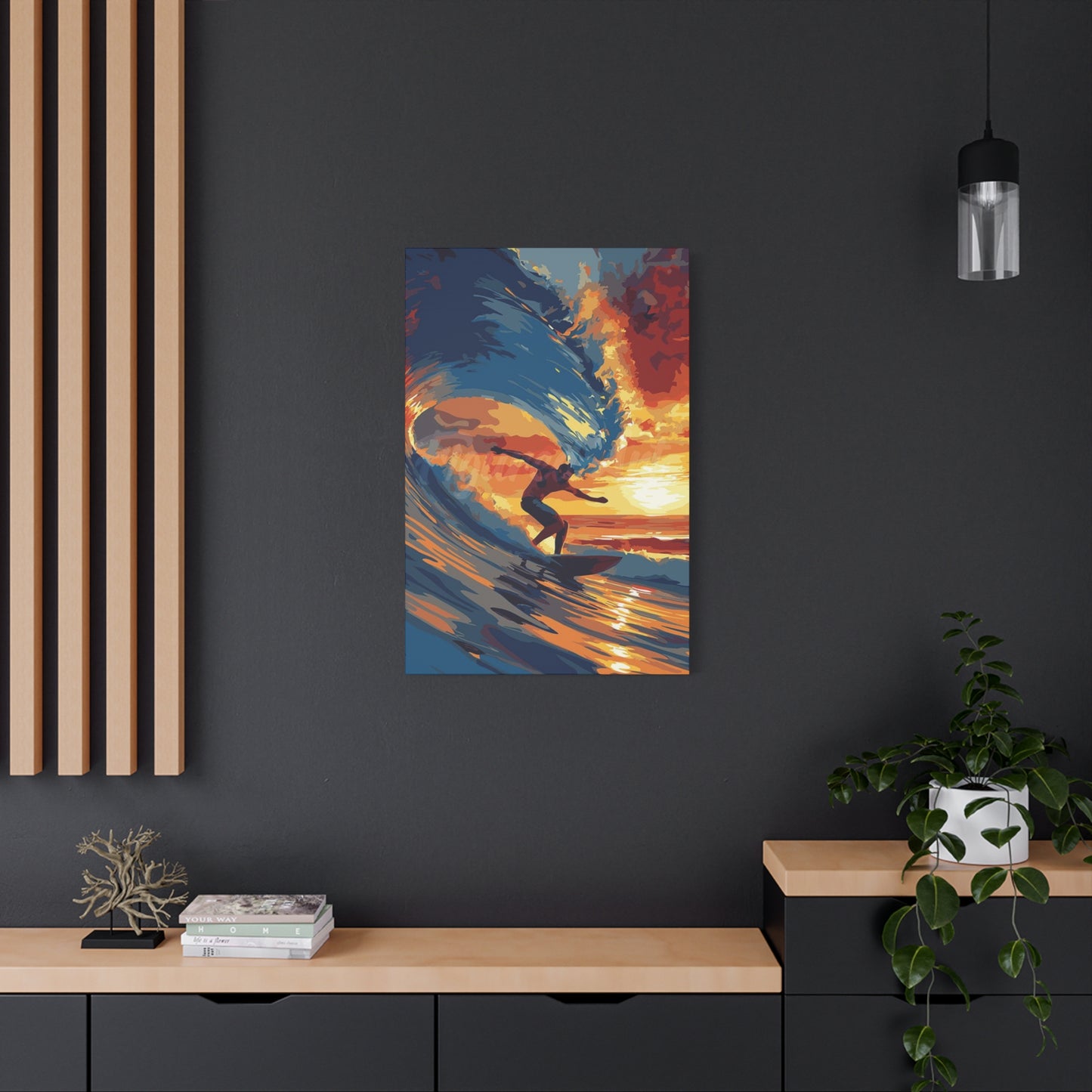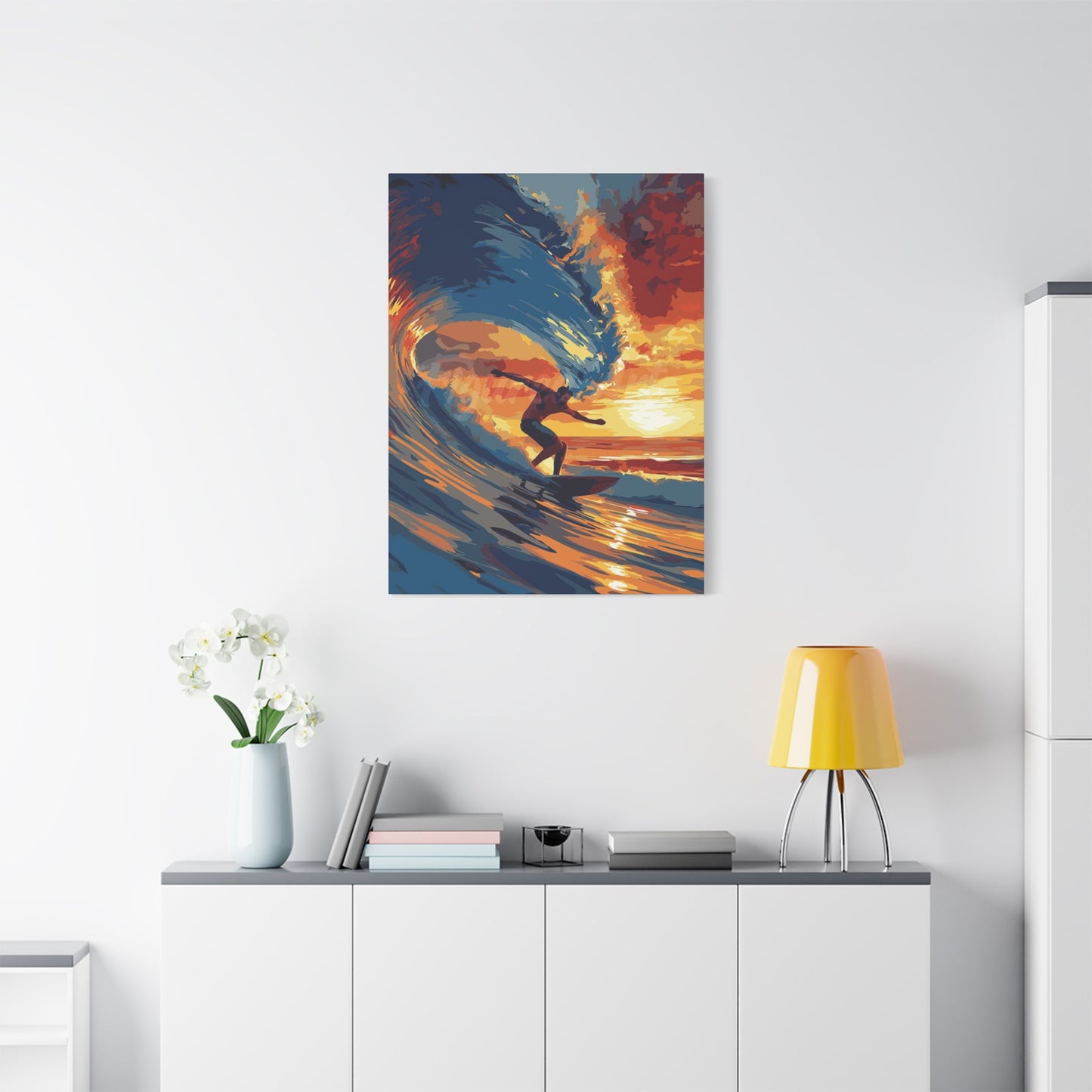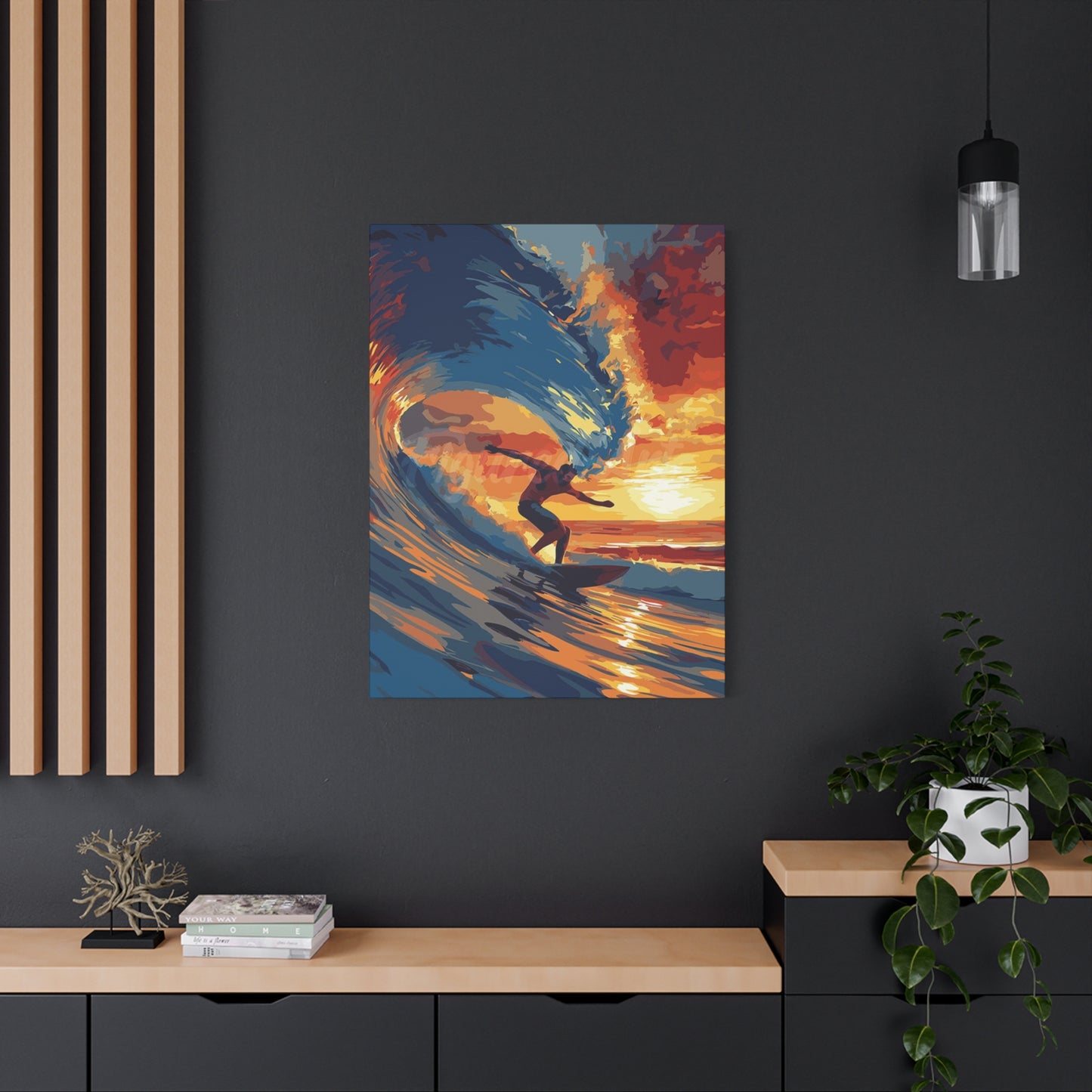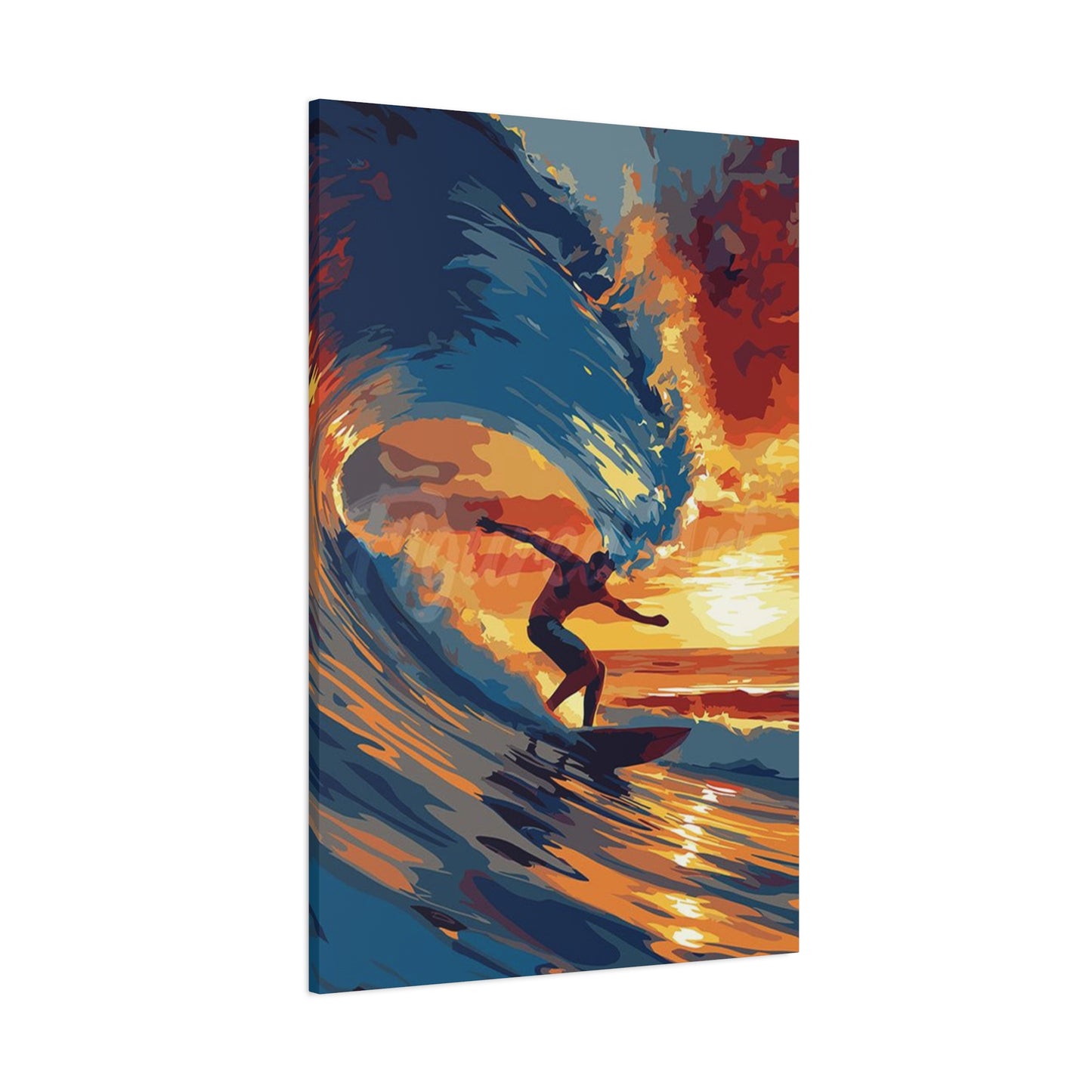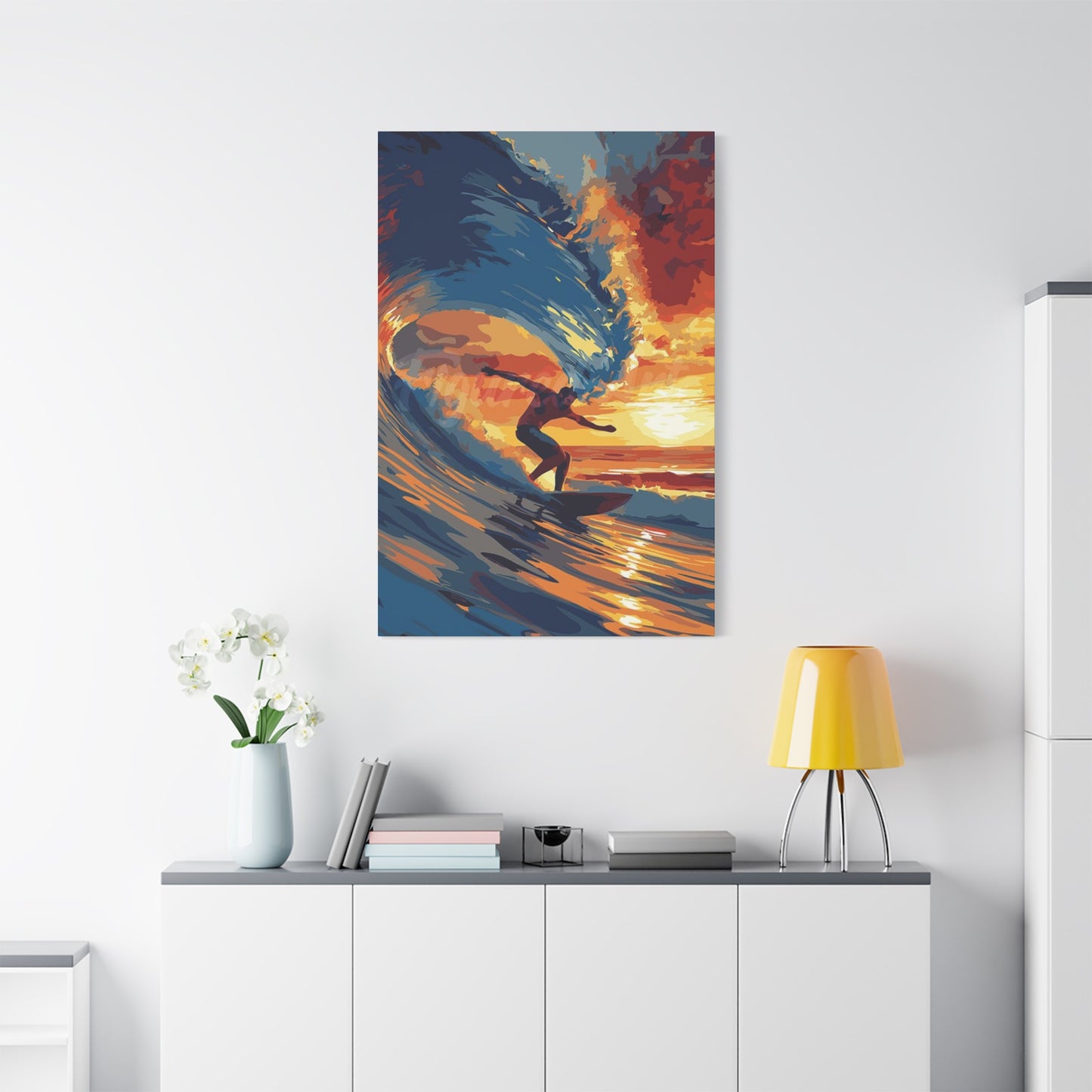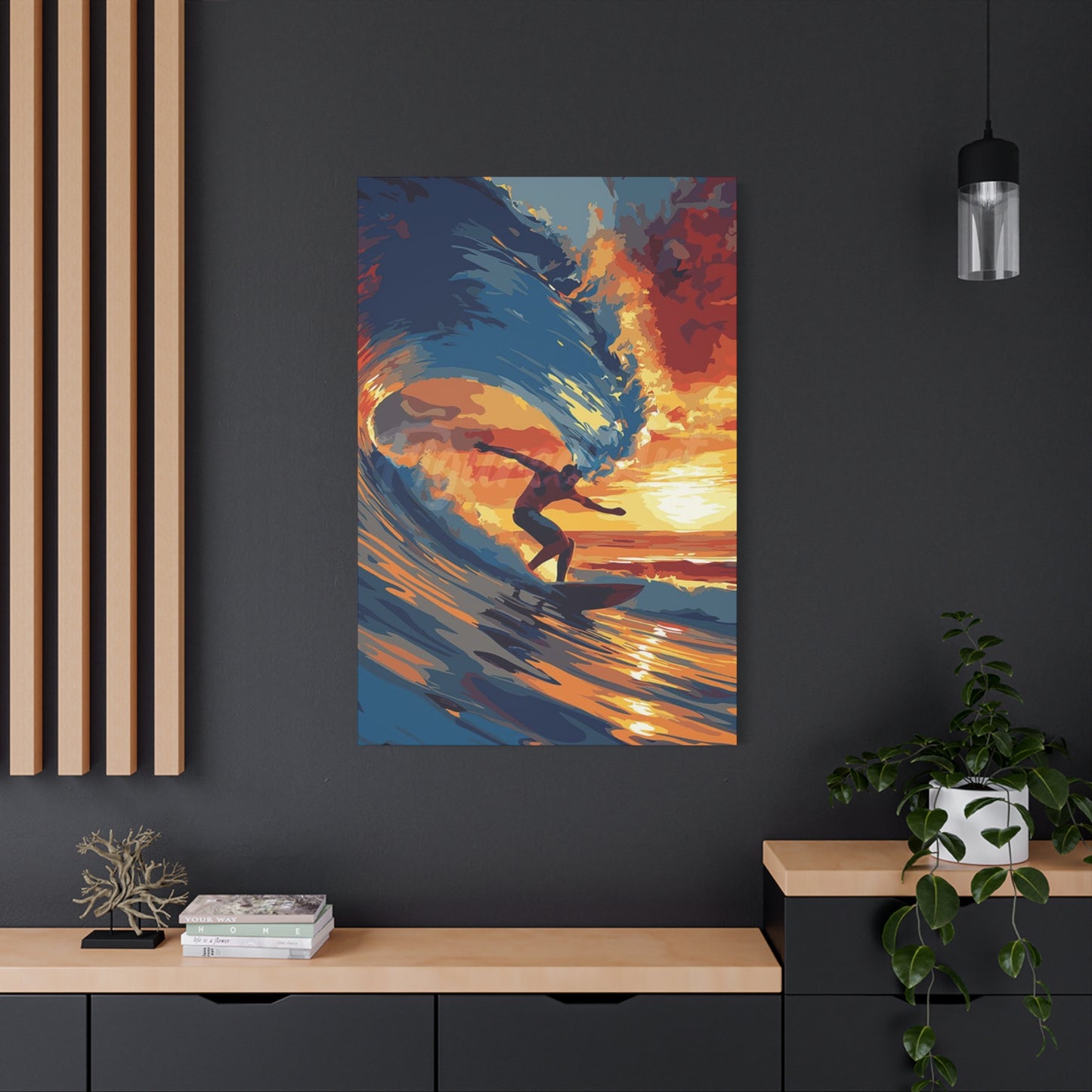Surfing Abstract Wall Art Canvas Prints: The Ultimate Guide to Ocean-Inspired Decor
The connection between human emotion and the ocean has been explored through artistic expression for centuries. When you combine the dynamic energy of surfing with abstract artistic principles, you create a powerful visual language that speaks to adventure seekers, beach lovers, and art enthusiasts alike. These artistic representations capture the essence of wave riding without relying on literal depictions, allowing viewers to interpret the movement, energy, and spirit of the sport through color, form, and texture.
Abstract interpretations of surfing culture offer a sophisticated approach to coastal decor. Unlike photographic reproductions or realistic paintings, these pieces distill the experience of riding waves into essential visual elements. The swirling patterns might represent water currents, while bold color choices evoke sunset sessions or the deep blue of offshore breaks. This artistic freedom allows designers and homeowners to incorporate the surfing lifestyle into their spaces without overwhelming rooms with overtly thematic decorations.
The popularity of these artistic pieces stems from their versatility. A well-executed abstract piece inspired by surfing culture can complement modern minimalist interiors, bohemian beach houses, or even corporate spaces seeking to convey innovation and fluidity. The universal appeal of ocean imagery combined with the intellectual sophistication of abstract art creates decorative options that transcend typical categorizations.
When selecting pieces for your space, consider how abstract interpretations allow for personal connection. Each viewer brings their own experiences and memories to the artwork, making these pieces deeply personal despite their non-representational nature. The curl of a wave might remind one person of their first surfing lesson, while another sees the cyclical nature of life's challenges and triumphs.
The Artistic Evolution of Surfing Culture Representation
Surfing culture has influenced visual arts since the sport gained mainstream popularity in the mid-twentieth century. Early artistic representations focused on documenting the physical act of wave riding, capturing surfers in action through photography and realistic painting. As the counterculture movement embraced surfing as a lifestyle rather than merely a sport, artistic interpretations evolved to capture the philosophical and spiritual dimensions of the experience.
Abstract approaches emerged as artists sought to convey the sensation of surfing rather than its appearance. The feeling of dropping into a wave, the adrenaline of speed, the meditative state achieved while waiting in the lineup these intangible elements became the subject matter. Artists experimented with gestural brushstrokes, fluid compositions, and color palettes that reflected the ocean's ever-changing moods.
Contemporary artists continue to push boundaries in representing surfing through abstract visual language. Some incorporate mixed media elements, layering textures that evoke the tactile experience of wax on a surfboard or the gritty feel of sand. Others use digital techniques to create pieces that pulse with energy, their compositions suggesting movement through dynamic arrangements of shape and color.
The transition from literal to abstract representation reflects broader trends in both art and surfing culture. As surfing has evolved from a niche pursuit to a globally recognized lifestyle and Olympic sport, its artistic representation has similarly matured. Abstract interpretations acknowledge the complexity of surfing culture, moving beyond simple beach scenes to explore themes of environmental consciousness, personal transformation, and the search for flow states.
This evolution has created a rich marketplace for collectors and decorators. Whether you prefer the spontaneous energy of action painting techniques applied to ocean themes or the calculated precision of geometric abstractions inspired by wave forms, contemporary artists offer diverse interpretations to suit any aesthetic preference.
Ocean-Inspired Abstract Compositions
Color choices in abstract artwork inspired by surfing carry significant psychological and emotional weight. The traditional palette of blues and greens immediately evokes the ocean environment, but the specific shades and their combinations can dramatically alter the mood and impact of a piece. Deep navy and indigo suggest the mysterious depths of offshore waters, creating feelings of contemplation and depth, while bright turquoise and aquamarine capture the exhilarating clarity of tropical breaks.
Beyond the obvious aquatic hues, many artists incorporate unexpected colors to represent different aspects of the surfing experience. Warm oranges and pinks might represent dawn patrol sessions or golden hour light reflecting off water surfaces. These sunset-inspired palettes bring warmth and optimism to spaces, creating inviting atmospheres that balance the coolness of ocean blues. The contrast between warm and cool tones can represent the dynamic tension at the heart of surfing itself, where surfers must harmonize with powerful natural forces.
White space in these compositions often represents foam, spray, or the explosive energy of a breaking wave. Strategic use of white creates visual breathing room and suggests the ephemeral nature of perfect waves. Some artists use metallic accents gold, silver, or bronze to suggest sunlight dancing on water or the fleeting magic of ideal conditions.
Darker palettes featuring blacks, deep grays, and stormy blues appeal to those drawn to surfing's more challenging aspects. These compositions might represent big wave surfing, winter sessions, or the ocean's raw power during storms. Such pieces create dramatic focal points in contemporary interiors, offering visual weight and sophistication while maintaining thematic connection to surfing culture.
The psychological impact of color extends beyond individual preference. Blues have been shown to reduce stress and promote calmness, making them ideal for bedrooms or meditation spaces. Energetic combinations of complementary colors like orange and blue create visual excitement suitable for creative workspaces or social areas. Understanding these principles helps in selecting artwork that not only appeals aesthetically but also supports the intended function of your space.
Compositional Techniques in Abstract Surfing Artwork
The arrangement of visual elements within abstract surfing-inspired artwork determines how successfully the piece conveys energy, movement, and emotion. Horizontal compositions naturally suggest the ocean's horizon line, creating a sense of expansiveness and tranquility. These layouts work particularly well above furniture pieces like sofas or beds, where they can visually extend the horizontal plane of the room.
Vertical orientations evoke the towering face of waves or the upward trajectory of aerial maneuvers. These compositions draw the eye upward, making them effective for spaces with high ceilings or narrow wall sections. The vertical format can suggest aspiration and challenge, reflecting the surfer's constant push to improve and take on bigger waves.
Diagonal and dynamic compositions inject energy and movement into the artwork. Lines that sweep across the canvas can represent the trajectory of a surfer carving across a wave face or the explosive power of water rushing up a reef. These arrangements prevent static viewing experiences, keeping the eye moving around the composition much like a surfer reads and responds to changing wave conditions.
Layering techniques add depth and complexity to abstract pieces. Translucent washes of color might be overlaid with bold gestural marks, creating visual depth that mirrors the ocean's layers visible through clear water. This approach allows artists to build complex color relationships and suggest the multidimensional nature of the surfing experience.
Balance between positive and negative space determines whether a composition feels crowded or spacious. Pieces with generous negative space evoke the minimalist aesthetic associated with surf culture's zen-like pursuit of simplicity. More densely packed compositions might represent the chaos of crowded lineups or the complex energy systems within ocean currents.
The rhythm established through repeated elements like wave-like curves or circular motifs creates visual unity while suggesting the cyclical nature of swell patterns and tides. This rhythmic quality makes abstract surfing artwork particularly suitable for spaces where a sense of flow and natural harmony is desired.
Material Considerations for Canvas Print Quality
The substrate upon which abstract surfing artwork is printed significantly impacts its visual quality and longevity. Traditional canvas remains the most popular choice due to its textile texture, which adds dimensionality and creates an authentic artistic feel. High-quality cotton canvas provides superior color absorption and durability compared to synthetic alternatives, though polyester blends offer improved moisture resistance beneficial for coastal environments.
Canvas weight, measured in grams per square meter, determines the material's durability and how well it maintains tension over time. Heavier canvases resist sagging and provide a more substantial presence, particularly important for larger pieces. For artwork featuring bold colors and high contrast, a medium to heavyweight canvas prevents the print from appearing thin or translucent.
The weave pattern of the canvas affects how details are rendered. Fine weaves support intricate details and smooth gradients, while more pronounced textures add character that complements the organic nature of ocean-themed imagery. Some artists specifically choose textured canvases to enhance the tactile quality of their work, creating surfaces that invite closer inspection.
Stretcher bars, the wooden frames over which canvas is pulled, must be substantial enough to prevent warping while remaining lightweight enough for safe wall mounting. Gallery-wrapped edges, where the image continues around the sides of the stretcher bars, eliminate the need for framing and create a contemporary, finished appearance. This presentation style suits abstract work particularly well, as it allows the artwork to exist as a pure object without the visual interruption of a frame.
Coating options protect prints from environmental factors while affecting their final appearance. Glossy finishes enhance color vibrancy and create reflective surfaces that can catch light dramatically, though they may produce glare in certain lighting conditions. Matte and satin finishes reduce reflections while offering a more subdued, gallery-quality appearance that many collectors prefer for abstract work.
Printing Technology and Color Reproduction
The printing method used to create canvas reproductions dramatically affects color accuracy, detail resolution, and longevity. Giclée printing, considered the gold standard for fine art reproduction, uses archival-quality inks and high-resolution printing to achieve exceptional detail and color fidelity. This process can reproduce the subtle tonal variations and complex color relationships essential to successful abstract artwork.
Pigment-based inks offer superior longevity compared to dye-based alternatives, with properly displayed prints maintaining their color intensity for decades. This longevity is particularly important for abstract pieces where color relationships form the core of the artistic statement. Fading or color shifting would fundamentally alter the artist's intent and the work's visual impact.
Color profile management ensures that the printed piece accurately reflects the artist's original digital file or painting. Professional print services calibrate their equipment regularly and use standardized color spaces to maintain consistency. For ocean-themed artwork, accurate reproduction of blues and greens is particularly critical, as these colors can easily shift toward cyan or teal if not properly managed.
Resolution determines how sharp and detailed the final print appears, especially when viewed up close. For abstract work featuring soft gradients and atmospheric effects, high resolution prevents banding and ensures smooth color transitions. Pieces with fine details or texture require even higher resolution to maintain clarity at larger sizes.
The size limitations of printing equipment affect available options for very large installations. Understanding the maximum print dimensions and how multiple panels can be used to create expansive compositions helps in planning gallery walls or statement pieces for large spaces. Seamless multi-panel printing requires precise alignment and color matching to maintain visual cohesion across the installation.
Size Selection for Different Spaces
Choosing appropriate dimensions for abstract surfing artwork requires consideration of wall space, viewing distance, and the room's overall design scheme. Undersized pieces can appear lost on large walls, failing to make the intended visual impact, while oversized artwork may overwhelm smaller spaces or create uncomfortable viewing experiences.
For living rooms and primary social spaces, large-scale pieces measuring four to six feet across create commanding focal points that anchor seating arrangements. These substantial works can transform entire rooms, establishing the color palette and mood for surrounding décor. When selecting pieces of this scale, ensure adequate viewing distance at least half the width of the artwork for comfortable perception of the composition as a whole.
Medium-sized pieces ranging from two to four feet work well in bedrooms, home offices, and dining areas. These dimensions provide visual interest without dominating spaces where other activities take precedence over art appreciation. In bedrooms particularly, medium-sized abstract ocean artwork can create a calming focal point above the headboard without overwhelming the restful atmosphere.
Smaller pieces under two feet offer versatility for creating gallery walls, flanking doorways, or filling narrow wall sections. When using multiple smaller pieces, maintain consistent spacing and consider how the individual works relate to each other compositionally. A collection of abstract surfing prints in varying sizes can tell a more complex story than a single large piece, with each work representing different aspects of ocean experience.
Vertical spaces like stairwells or narrow walls between windows benefit from tall, narrow compositions or vertically arranged series. These challenging spaces often go underutilized but can become striking design features with appropriately proportioned artwork. Consider how the piece will be viewed as viewers move through the space, potentially seeing different aspects from various angles.
For commercial spaces or large homes with dramatic architecture, oversized installations spanning eight feet or more create memorable impressions. These statement pieces require professional installation and careful integration with the architectural features of the space. The investment in scale pays dividends in creating distinctive, memorable environments that reflect sophisticated design sensibilities.
Framing and Presentation Options
While many contemporary canvas prints feature gallery-wrapped edges that eliminate the need for traditional frames, various presentation options allow for customization based on aesthetic preferences and protective requirements. Floating frames create a sophisticated border around gallery-wrapped canvases, adding visual weight while maintaining the modern frameless aesthetic. These frames hover slightly away from the canvas edges, creating dimensional interest and protecting corners from damage.
Traditional frames with matting offer a more classic presentation suitable for bridging contemporary abstract artwork with traditional interior design elements. However, matting can visually separate the artwork from the viewer, reducing the immersive quality that abstract ocean imagery often seeks to achieve. When using frames, consider thin, simple profiles that don't compete with the artwork's visual complexity.
Shadow box frames create significant depth between the artwork and the wall, producing dramatic shadows that change throughout the day as lighting conditions shift. This presentation style emphasizes the artwork as an object rather than simply an image, adding sculptural qualities appropriate for abstract work. The added dimension works particularly well with textured canvas surfaces that benefit from directional lighting.
Frameless mounting systems using hidden brackets create the illusion of artwork floating directly against the wall. This minimalist approach suits abstract compositions that benefit from uninterrupted visual flow into the surrounding space. The clean aesthetic aligns with the simplicity valued in surf culture while allowing the artwork itself to command full attention.
For collections or series, unified framing creates cohesion while allowing individual pieces to maintain their identity. Consistent frames or mounting styles across a gallery wall help viewers understand relationships between pieces while the varied compositions maintain visual interest. This approach works particularly well for abstract interpretations of different surf breaks, wave conditions, or times of day.
Protective glazing using UV-filtering acrylic or glass extends the life of prints while reducing glare. Though less common for canvas prints than for paper-based artwork, glazing can be valuable in high-light environments or coastal locations where environmental factors might accelerate degradation. Anti-reflective coatings on glazing materials maintain visual clarity while providing protection.
Placement Strategies for Maximum Impact
Strategic positioning of abstract surfing artwork can transform how effectively it enhances your space and supports your daily activities. The traditional guideline of hanging artwork at eye level approximately 57-60 inches from the floor to the piece's center provides a useful starting point, but should be adjusted based on ceiling height and furniture placement. In rooms with tall ceilings, slightly elevated positioning prevents artwork from feeling disconnected from the living space.
Above seating areas, maintain 8-12 inches between the furniture top and the artwork's bottom edge. This spacing creates visual connection without the artwork appearing to press down on the seating. For abstract ocean pieces used in conversation areas, this positioning allows seated guests to comfortably appreciate the work while also feeling embraced by its presence.
Lighting dramatically affects how abstract artwork appears and should be carefully considered during placement. Natural light brings artwork to life but can also cause fading over time. Position pieces on walls perpendicular to windows rather than directly across from them to minimize direct sun exposure while benefiting from ambient natural light. For artificial lighting, adjustable track lighting or picture lights allow you to highlight specific aspects of the composition.
Corner placements can activate underutilized spaces while creating interesting viewing angles. Abstract pieces work particularly well in corners because their non-representational nature remains compelling from oblique viewing positions. This placement strategy works especially well in open-plan spaces where the same artwork will be viewed from multiple positions throughout the day.
Creating visual dialogue between artwork and architectural features enhances both elements. Position pieces to emphasize architectural lines, frame interesting views, or create rhythm through repetition of forms. An abstract wave composition might echo the curved lines of an archway, while linear arrangements of multiple pieces can emphasize the horizontal expanse of a long wall.
In bathrooms and kitchens, where moisture and temperature fluctuations present challenges, select locations away from direct water exposure and heat sources. Abstract ocean artwork can transform these utilitarian spaces into spa-like retreats, but positioning must account for practical concerns. Proper sealing and protective coatings become essential in these environments.
Creating Gallery Walls with Ocean-Themed Abstract Art
Curating a collection of abstract surfing prints into a cohesive gallery wall requires balancing variety with unity, creating visual interest while maintaining overall harmony. Begin by establishing a unifying element whether a consistent color palette, similar compositional approaches, or related thematic content. This throughline allows diverse pieces to coexist while telling a larger story about ocean experience and surfing culture.
Layout planning should occur before any installation. Create paper templates matching your artwork dimensions and experiment with arrangements on the floor or use painter's tape to map positions directly on the wall. Consider how the eye will move through the collection, creating paths that encourage exploration while maintaining overall balance. Asymmetrical arrangements often feel more dynamic and contemporary than rigid grids, though both approaches can succeed with careful execution.
Spacing between pieces affects whether the gallery wall reads as a unified installation or a collection of individual works. Tighter spacing of 2-3 inches creates a cohesive whole, while 4-6 inches allows each piece more independence. Consistent spacing throughout the arrangement usually produces more professional results than varied gaps, regardless of which measurement you choose.
Mixing sizes adds visual interest and prevents monotony. A large anchor piece can ground the arrangement, with smaller works clustered around it in supporting roles. This hierarchical approach mirrors the natural world, where dominant waves are surrounded by smaller undulations and ripples. The largest piece often works best positioned slightly off-center, with the arrangement's visual weight balanced through careful positioning of remaining works.
Color distribution across the gallery wall prevents clumping of similar tones while creating rhythmic movement. If working with pieces featuring strong blues, distribute them throughout the arrangement rather than grouping them together. This scattering of dominant colors leads the eye around the entire installation rather than creating static zones of similar visual weight.
Incorporating different orientations square, horizontal, and vertical formats creates dynamic tension and prevents predictability. The varied formats can represent different aspects of the surfing experience: horizontal pieces suggesting the ocean's expanse, vertical works evoking the powerful face of waves, and square formats offering balanced, contemplative compositions.
Consider the negative space the wall area surrounding and between artworks as an active design element rather than leftover space. In abstract work particularly, the breathing room around pieces allows each composition to exist fully without visual interference from neighbors. The wall color itself becomes part of the overall composition, with light neutrals creating gallery-like sophistication while darker walls can make colors appear more vibrant.
Style Integration with Interior Design Trends
Abstract surfing artwork adapts remarkably well to diverse interior design styles, from ultra-modern minimalism to comfortable coastal casual. Understanding how to integrate these pieces with various aesthetic approaches ensures they enhance rather than conflict with your existing décor. In minimalist spaces characterized by clean lines and restrained color palettes, select abstract pieces with generous negative space and limited color schemes. The artwork should embody the same principles of simplicity and intentionality that define minimalist design.
Coastal contemporary interiors provide natural homes for abstract ocean artwork, but avoid obvious or cliché coastal symbols. Let the artwork represent the sophistication of surf culture rather than cartoon waves and anchors. Pair abstract pieces with natural materials like weathered wood, linen textiles, and stone elements to create layered, nuanced coastal environments that feel collected and authentic.
Mid-century modern spaces benefit from abstract surfing art that emphasizes bold colors and geometric elements. Look for pieces that echo the optimistic color palettes and organic shapes characteristic of this era while bringing contemporary sensibilities. The connection between mid-century design and surf culture's golden age creates natural synergy when thoughtfully executed.
Industrial spaces with exposed brick, metal elements, and concrete surfaces gain warmth and humanity through abstract ocean artwork. The organic forms and fluid compositions contrast beautifully with hard-edged industrial materials, creating dynamic tension. Large-scale pieces work particularly well in industrial spaces, where high ceilings and open floor plans can accommodate substantial artworks.
Scandinavian design's emphasis on light, natural materials, and connection to nature makes it highly compatible with abstract interpretations of surfing and ocean themes. Select pieces with the muted, sophisticated color palettes associated with Scandinavian aesthetics dusty blues, soft grays, and warm naturals. The artwork should feel calm and contemplative rather than visually aggressive.
Bohemian interiors embrace maximalism and eclectic mixing, allowing for more experimental approaches to abstract surfing art. Layer multiple pieces, combine different sizes freely, and don't shy away from bold colors. The relaxed, creative spirit of bohemian design aligns naturally with surf culture's free-spirited ethos.
Traditional spaces can successfully incorporate abstract ocean artwork when the pieces are properly framed and positioned as intentional focal points. The key lies in balancing the contemporary nature of abstract art with the room's classical elements. Substantial frames and symmetrical positioning help bridge the aesthetic gap between traditional furnishings and contemporary artwork.
The Role of Texture in Abstract Canvas Prints
Texture adds crucial dimensionality to abstract canvas prints, transforming them from purely visual experiences into works that engage multiple senses. Even though viewers typically don't touch gallery walls, the suggestion of texture creates psychological engagement and perceived depth that flat, smooth prints cannot achieve. Understanding how texture functions in abstract surfing artwork helps in selecting pieces that create maximum impact.
Physical texture in the canvas substrate itself provides foundation-level dimensionality. The woven nature of canvas creates subtle surface variation that catches light differently than smooth paper or metal prints. This inherent texture suits abstract ocean imagery perfectly, as the slight irregularities suggest the natural imperfections of wind-textured water surfaces or the organic qualities of sand and foam.
Some printing techniques can add dimensional texture to the surface, creating genuine relief that extends beyond the base canvas. Gel mediums, textured varnishes, and mixed media elements applied after printing create tangible surface variations. These enhancements are particularly effective in abstract work, where texture itself becomes an expressive element rather than merely reproducing the texture of real objects.
Visual texture creates the illusion of surface variation through artistic technique rather than physical dimension. Skilled artists use brushwork patterns, layering strategies, and mark-making to suggest texture convincingly. In abstract surfing art, visual texture might represent the choppiness of wind-blown water, the smoothness of glassy conditions, or the explosive chaos of whitewater.
Contrast between textured and smooth areas creates visual interest and guides the viewer's eye through the composition. Rough, highly textured sections demand attention and suggest energy or turbulence, while smooth gradients offer visual rest and contemplative space. This interplay mirrors the actual experience of surfing, where moments of intense action alternate with periods of patient waiting.
Scale affects how texture is perceived. In large pieces viewed from distance, subtle texture may not register consciously but still contributes to the overall richness of the viewing experience. Up close, that same texture becomes a focal point that rewards detailed inspection. Consider viewing distances when selecting pieces with pronounced texture, ensuring they function effectively from where they'll typically be seen.
Lighting dramatically affects how texture appears, with raking side light emphasizing surface variations while flat frontal lighting minimizes them. Adjustable lighting allows you to control how dramatically texture presents itself at different times of day or for different occasions. This dynamic quality keeps artwork from becoming static or predictable over time.
Abstract Art as Emotional Expression of Surfing
Beyond depicting physical waves or surfers, abstract artwork captures the emotional and psychological dimensions of surfing that realistic representation cannot fully convey. The sport provides intense experiences that range from meditative calm to adrenaline-charged excitement, and abstract visual language can express these internal states more directly than literal imagery.
The anticipation before paddling out, that mixture of excitement and nervousness when facing new conditions, translates into visual tension in abstract compositions. Artists might use color contrasts, unexpected juxtapositions, or compositional instability to evoke these pre-surf emotions. Collectors who surf recognize these feelings immediately, while non-surfers can still access the universal experience of anticipating challenges.
The flow state achieved during a perfect wave, when conscious thought dissolves and instinct takes over, inspires abstract work characterized by fluid, uninterrupted lines and harmonious color relationships. These pieces often feature sweeping curves and smooth gradients that suggest effortless movement. The artwork itself can induce similar meditative states in viewers, providing visual pathways that quiet mental chatter.
Wipeouts and the violent tumbling underwater that follows find expression through chaotic compositions, fractures patterns, and aggressive mark-making. These pieces don't shy away from surfing's dangers but instead honor the totality of the experience. The visual chaos can be cathartic for surfers who've experienced serious wipeouts while remaining aesthetically compelling to viewers who appreciate dynamic abstraction.
The deep connection to nature that surfing cultivates appears in abstract work through organic forms, natural color progressions, and compositions that suggest larger cycles and systems. Artists might reference tidal patterns, seasonal changes in wave quality, or the way ocean conditions reflect atmospheric phenomena. These pieces speak to environmentally conscious viewers who recognize surfing's dependence on healthy ecosystems.
The community aspects of surfing, the unspoken rules and mutual respect in the lineup, can inform abstract work through balanced compositions, rhythmic repetitions, and harmonious relationships between elements. Just as surfers must coexist in limited space with limited waves, compositional elements in these pieces interact without conflict, each finding its place within the whole.
Post-session satisfaction, that deeply contented state after hours in the water, translates into abstract compositions featuring warm colors, balanced arrangements, and resolved tensions. These pieces provide visual comfort and can transform living spaces into extensions of the peaceful feeling that follows great surf sessions.
Environmental Themes in Ocean-Inspired Abstract Art
Contemporary abstract artwork inspired by surfing increasingly incorporates environmental consciousness, reflecting surf culture's growing awareness of ocean health threats. These pieces go beyond celebrating the beauty of waves to engage with complex ecological realities, using abstract visual language to process environmental concerns without heavy-handed didacticism.
Some artists incorporate actual ocean debris plastic fragments, fishing line, or degraded materials into their work, creating texture and meaning simultaneously. These mixed-media approaches make abstract statements about pollution while maintaining aesthetic integrity. The tension between beauty and damage in these works mirrors the ocean's current state: still magnificent but increasingly compromised.
Color choices can reflect environmental themes, with polluted water colors murky browns, toxic greens, or oily rainbow sheens appearing alongside pristine blues. The contrast within a single composition can represent the ocean's dual reality or the before-and-after of environmental degradation. These pieces challenge viewers to consider their relationship with marine environments.
Fragmentation in abstract compositions might represent ecosystem breakdown, with isolated elements suggesting disconnected food webs or disrupted migration patterns. The visual discomfort of fragmented compositions can metaphorically represent the discomfort of environmental awareness, encouraging reflection without prescribing specific responses.
Some abstract work references rising ocean temperatures through warm color dominance or the visual distortion and dissolution of forms. These pieces capture the invisible threat of climate change, making abstract but powerful statements about forces reshaping surf breaks and ecosystems globally.
Regeneration and hope also appear in environmentally conscious abstract work. New growth, renewal, and resilience find expression through layered compositions where life pushes through darkness, or through color progressions that suggest healing and recovery. These pieces acknowledge problems while maintaining optimism about positive change.
The abstract approach to environmental themes allows artwork to function on multiple levels. Viewers can appreciate purely aesthetic qualities without engaging environmental content, or they can read deeper meanings based on their own awareness and concerns. This multiplicity makes the work accessible while allowing for significant depth.
Historical Context of Surf Art Evolution
Surfing's artistic documentation began with Hawaiian natives who considered wave riding a sacred practice intertwined with their spiritual and social systems. Early Western observers created documentary artwork attempting to capture this foreign activity for audiences who had never seen the ocean. These initial representations focused on anthropological accuracy rather than artistic interpretation.
The early twentieth century surf tourism boom inspired promotional artwork that idealized Hawaiian beaches and the surfing lifestyle. Travel posters from this era used stylized representations to sell exotic vacations, establishing visual tropes that would influence surf art for decades. The emphasis remained on literal representation, showing identifiable locations and activities.
Post-World War Two surf culture development on the California coast generated new artistic approaches. The counterculture movement's embrace of surfing as a lifestyle rather than sport opened space for more experimental representation. Surf publications featured psychedelic artwork, experimental photography, and increasingly abstract design elements that attempted to capture the altered consciousness many surfers associated with their practice.
The 1960s and 1970s saw significant cross-pollination between surf culture and contemporary art movements. Abstract expressionism's emphasis on gestural mark-making and emotional authenticity resonated with surfers' experiences. Some artists who surfed began explicitly connecting their ocean experiences with their abstract work, though mainstream art world recognition remained limited.
The 1990s action sports boom brought surf culture into mainstream consciousness while also commercializing many of its authentic elements. Simultaneously, a counter-movement emerged among artists seeking to represent surfing's deeper, more personal dimensions. Abstract approaches allowed these artists to differentiate their work from commercial surf imagery while accessing more profound truths about the practice.
Contemporary digital tools have revolutionized how abstract surf art is created and distributed. Artists can manipulate photographs of waves into abstract compositions, create entirely digital works, or use technology to augment traditional media. The democratization of image-making and distribution has generated an explosion of surf-inspired abstract work, though distinguishing exceptional pieces from derivative work requires educated eyes.
Today's mature surf art market includes serious collectors, dedicated galleries, and artist reputations built specifically around ocean-inspired work. Abstract approaches have gained respect as legitimate artistic responses to surfing rather than merely decorative renditions. This evolution reflects both surfing's cultural maturation and broader acceptance of abstraction in contemporary art discourse.
Technical Aspects of Photographing Waves for Abstract Transformation
Many abstract surfing artworks begin with wave photography that's subsequently manipulated, abstracted, or used as inspiration for original compositions. Understanding the technical considerations of capturing wave images reveals the foundation beneath seemingly non-representational artwork and informs appreciation of the final abstract pieces.
Shutter speed selection dramatically affects how water appears in photographs. Fast speeds freeze motion, capturing individual droplets and spray patterns with crystalline clarity. These frozen moments reveal the sculpture-like qualities of water, providing source material for abstract work emphasizing form and structure. Slow shutter speeds blur movement, creating silky, ethereal effects that suggest motion and time passing. These impressionistic captures lend themselves to abstract interpretations focused on energy flow rather than specific forms.
Perspective dramatically influences compositional possibilities. Photographing from water level using underwater housings or floating cameras creates intimate perspectives that place viewers inside the wave experience. The distortion and refraction effects when shooting partially submerged generate organic abstractions even in the original photographic capture. Aerial perspectives from drones or elevated positions reveal patterns and relationships invisible from ground level, offering god's-eye views that naturally abstract the scene.
Light quality transforms water's appearance from moment to moment. Direct sunlight creates high contrast and saturated colors, while overcast conditions produce subtle tonal gradations. Backlit waves become translucent, revealing the water's internal structure and color variations. Golden hour light adds warmth and drama, while the blue hour's cool tones create mysterious, contemplative moods. Artists working from photographic source material must capture these varying conditions to provide diverse starting points for abstract interpretation.
Color temperature and white balance settings affect the emotional tone of wave photography. Cooler color temperatures emphasize blues and create distancing effects, while warmer settings increase yellows and oranges, generating approachable, optimistic feeling. Artistic license in color manipulation during editing allows photographers to shift reality toward expressive ends, preparing the ground for full abstraction.
Compositional choices during capture establishing the placement of horizons, the balance of sky and water, and the arrangement of wave forms provide structure that persists through subsequent abstraction. Strong compositions in the source photography typically translate into strong abstract work, even when all recognizable elements are eventually eliminated or transformed beyond recognition.
Post-capture processing techniques ranging from simple exposure and color adjustments to complex compositing, filters, and digital painting provide the bridge between photographic documentation and abstract artwork. Understanding this transformation process deepens appreciation for how contemporary abstract surf art often builds on photographic foundations while transcending literal representation.
Regional Surf Cultures and Their Visual Aesthetics
Different surfing regions worldwide have developed distinct cultural identities that influence the abstract artwork inspired by their breaks, communities, and environmental characteristics. Understanding these regional variations enriches interpretation of abstract pieces and helps collectors select work that resonates with specific locations or experiences.
Hawaiian surfing culture, rooted in ancient traditions and respect for ocean power, inspires abstract work characterized by spiritual depth and reverence. Colors might reference volcanic rock, tropical sunsets, and the incredibly clear water of reef breaks. The compositions often balance power and peace, reflecting the islands' dual nature as both paradise and site of serious, consequence-heavy surfing.
California surf culture's laid-back but innovative character generates abstract work that's simultaneously relaxed and experimental. The long history of counterculture connections makes California surf art particularly open to avant-garde approaches. Color palettes might reference golden sand, cliff-lined coasts, and the particular blue-gray of Pacific waters as filtered through coastal fog.
Australian surf culture's emphasis on fitness, competition, and beach lifestyle produces dynamic, energetic abstract work. The brilliant colors of tropical Queensland contrast with the cooler tones of southern breaks. The country's vast coastline and variety of wave types inspire corresponding diversity in abstract interpretations, from the powerful barrels of the Gold Coast to the playful point breaks of Byron Bay.
Indonesian surf culture, where international surf travelers encounter traditional island communities, generates abstract work that often incorporates cultural fusion themes. The incredibly warm water colors turquoise and jade dominate palettes, while compositions might reference both the perfection of the waves and the complexity of tourism's impact on local communities.
European surf culture, developing in colder waters and less consistent conditions, inspires abstract work that often emphasizes dedication and the value of hard-won sessions. The moody colors of Atlantic storms and the slate grays of winter sessions appear frequently. The integration of surfing into ancient coastal communities creates interesting contrasts that inform artistic interpretations.
Central and South American surf culture combines powerful waves with vibrant local cultures, inspiring abstract work rich in color and rhythm. The warm water, consistent swell, and developing surf tourism create a distinctive atmosphere that artists capture through bold compositions and tropical palettes tempered by acknowledgment of socioeconomic complexities.
Selecting Abstract Surfing Art for Different Personality Types
Individual personality traits and preferences should guide artwork selection to ensure chosen pieces enhance daily life rather than merely filling wall space. Understanding how different personality types respond to various artistic approaches helps match collectors with ideal pieces that will provide lasting satisfaction.
Adventurous, risk-taking personalities typically respond well to dynamic abstract compositions featuring bold colors, energetic brushwork, and unstable or tension-filled arrangements. These pieces mirror the thrill-seeking nature of aggressive surfing and provide visual stimulation that matches high-energy lifestyles. Large-scale works make strong statements appropriate for confident personalities unafraid of commanding attention.
Contemplative, introspective individuals often prefer subtle, nuanced abstract work featuring gentle gradations, harmonious color relationships, and balanced compositions. These pieces support meditation and reflection, creating calm spaces for processing thoughts and emotions. The surfing elements might be barely suggested rather than obvious, allowing for personal interpretation and discovery.
Analytical, detail-oriented personalities appreciate abstract work with technical sophistication, whether in execution, concept, or composition. Geometric abstractions of wave forms, pieces exploring color theory systematically, or work that rewards close inspection with hidden details appeal to minds that enjoy decoding complexity. These viewers appreciate understanding the artistic process and technical challenges overcome.
Conclusion
Surfing abstract wall art canvas prints offer a unique and dynamic way to introduce the spirit of the ocean into your living space. Combining the raw energy of the surf with the creativity of abstract design, these artworks serve as more than just decoration—they evoke the movement, color, and vitality of the sea, bringing the essence of coastal living into your home.
Choosing surfing abstract wall art for your space is an opportunity to showcase your love for both the sport and the ocean while embracing modern, contemporary aesthetics. These pieces transcend traditional surfing imagery, transforming the beauty of the surf into a visual language of swirling colors, fluid lines, and bold shapes. The result is artwork that captures the energy and motion of the ocean, while offering an artistic interpretation that feels fresh, modern, and highly personal.
One of the most compelling aspects of surfing abstract art is its versatility. Whether you want to inject bold, vibrant colors into a neutral-toned room or add a serene, calming vibe to a space with more muted hues, surfing abstract canvas prints can be customized to suit your decor style. You can find prints that capture the bright, playful aspects of surf culture, or opt for more subdued and minimalist designs that evoke the quiet power of the ocean.
These prints can seamlessly complement a variety of interior design themes. For coastal homes, they reinforce the beachy, relaxed aesthetic that defines the lifestyle. In more urban settings, surfing abstract art adds a touch of coastal cool and dynamic energy to a modern or industrial space. The flowing, organic shapes of abstract art also make it a perfect fit for minimalist decor, where the emphasis is on clean lines and simplicity. Ultimately, surfing abstract canvas prints bring a sense of movement and life to your space, grounding it in the natural world while inspiring creativity and connection.
In addition to their aesthetic appeal, abstract surfing art can also be a conversation starter. The abstract nature of the artwork invites viewers to interpret it in their own way, making each piece unique to the observer. Whether it reminds someone of a specific wave or evokes feelings of adventure, freedom, and calm, the abstract quality of the art allows for endless interpretations. This makes it ideal for those who appreciate art that is open to personal connection and interpretation.
When it comes to displaying surfing abstract wall art, the canvas medium adds another layer of richness to the overall experience. The texture and depth of canvas prints provide a more tactile, immersive feel compared to traditional framed prints or posters. Canvas is also highly durable, ensuring that your artwork remains vibrant and intact over time, even in areas with high sunlight exposure. Whether hung in the living room, bedroom, or even a home office, these prints serve as a long-lasting reminder of the dynamic beauty of the ocean.
For those looking to create a truly personalized touch, you can even explore custom abstract surfing art. By commissioning a piece that aligns perfectly with your vision and the unique atmosphere of your home, you can elevate your space in a way that feels even more meaningful. Custom art brings an added sense of authenticity and ownership to your decor, making it a one-of-a-kind addition to your home.
In conclusion, surfing abstract wall art canvas prints are a bold, creative, and impactful way to bring the ocean’s energy and beauty into your living space. They provide a fresh, artistic take on surf culture while infusing your home with the freedom, movement, and colors of the sea. Whether you're looking to add a pop of color, create a calming retreat, or simply celebrate the ocean’s endless inspiration, surfing abstract art offers endless possibilities. Its versatility, emotional resonance, and timeless appeal make it an ideal choice for anyone who wishes to surround themselves with the spirit of the surf and the ocean, right at home.

















